|
Click to listen to this article
|
By Mary Ruth McDonald, Tyler Blauel and Kevin Vander Kooi, University of Guelph
The carrot weevil (CW) is an important pest of carrots in Ontario, Canada, especially early in the season. This weevil, Listronotus oregonensis, can cause high levels of crop loss in the high organic matter soils of the Holland Marsh, Ontario, Canada.
The adult CW is active early in the season, even before most carrots are seeded. The adult overwinters in sheltered areas at the edges of fields and walks into the field in early May in Ontario. The weevils begin looking for carrots that are suitable in size to deposit their eggs. Generally, carrot weevils do not feed on carrots, or deposit eggs, until after the first true leaf stage.
The larvae hatch and begin feeding and tunneling through the upper third of the carrot root (Fig. 1). Larval feeding on small carrots, during the fourth to sixth leaf stage, often kills the carrot. Feeding on larger carrots can often go unnoticed until harvest, and this feeding damage renders the carrot unmarketable.
Carrot weevil feeding has caused damage and crop loss in past years in the marsh. In 2016, an average of 7 percent of carrots were lost due to CW (Fig. 2), despite the application of insecticides. Growers were regularly applying Imidan 70-W (a.i. phosmet) for many years, and it is likely that CW was developing resistance, as the product was no longer as effective as it used to be.




Research Trials
In 2016, research trials at the University of Guelph Ontario Crop Research Centre – Bradford (formerly the Muck Crops Research Station) began testing new insecticides for CW control. The insecticide Diamond (in Canada – Rimon 10 EC; a.i. novaluron) was effective and resulted in lower damage (13 percent) compared to the untreated check (35 percent) and Imidan (27 percent). Further trials testing other insecticides found Exirel (a.i. cyantraniliprole) was also effective in controlling CW with lower overall damage (17 percent).

Once effective products were found, the next question was when to apply these products to obtain the best results. Insecticide timing trials took place in 2018 and 2019 to investigate this. Diamond was applied at different leaf stages, and carrots were evaluated at harvest. Diamond applied at the second leaf stage, and again at the fourth leaf stage in high-pressure fields, was the most effective to minimize damage and maximize yield at harvest compared to the untreated check (Fig. 3).
In addition to effective insecticides and well-timed applications, choice of seeding date can avoid CW damage. Late seeding can avoid a high-pressure window. To test this, seeding date trials were conducted without the use of insecticides. Carrots planted earlier in the season, April to the first half of May, had higher CW damage (82 percent) compared to carrots seeded in late May or later (12 to 40 percent). This makes sense as CW are active earlier in the season and require a developing carrot plant to lay their eggs. Carrots seeded later in the season avoid the main egg laying period and, therefore, often end up with less damage.

Management Recommendations
Scouting and trapping for CW adults is important to know if CW are present in your field, and this starts early in the growing season. Wooden (Boivin) traps (Fig. 4) are set up at the edges of fields before carrots are seeded and are moved into rows after seeding. This trap uses a carrot bait as a lure, and the number of CW found in a field relates to spray thresholds. Generally, if a cumulative 1.5 CW/trap are found, a Diamond or Exirel spray is recommended at the second leaf stage. If the field has over five CW/trap, another spray is recommended at the fourth leaf stage.
Our monitoring of carrot fields, damage and CW egg laying sites has also observed a possible second generation of CW, which we are currently studying to understand more thoroughly.
Successful management of carrot weevil involves scouting, effective insecticides, good spray timing and possibly altering the seeding date. These have decreased the overall CW damage to 0.2 percent, on average.
For more information on carrot weevil management, check out the “How to Control Carrot Weevil” video on the Muck Crops IPM YouTube channel. Details of the trials can be found on the research station website at https://bradford-crops.uoguelph.ca.

